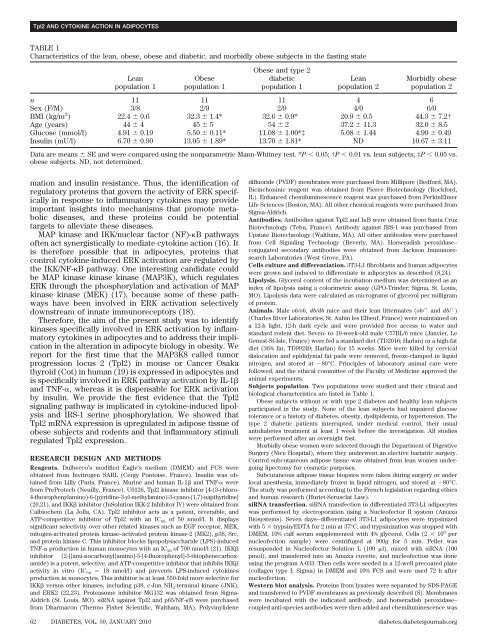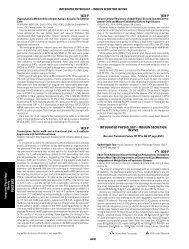Tpl2 Kinase Is Upregulated in Adipose Tissue in Obesity ... - Diabetes
Tpl2 Kinase Is Upregulated in Adipose Tissue in Obesity ... - Diabetes
Tpl2 Kinase Is Upregulated in Adipose Tissue in Obesity ... - Diabetes
You also want an ePaper? Increase the reach of your titles
YUMPU automatically turns print PDFs into web optimized ePapers that Google loves.
<strong>Tpl2</strong> AND CYTOKINE ACTION IN ADIPOCYTES<br />
TABLE 1<br />
Characteristics of the lean, obese, obese and diabetic, and morbidly obese subjects <strong>in</strong> the fast<strong>in</strong>g state<br />
Lean<br />
population 1<br />
Obese<br />
population 1<br />
mation and <strong>in</strong>sul<strong>in</strong> resistance. Thus, the identification of<br />
regulatory prote<strong>in</strong>s that govern the activity of ERK specifically<br />
<strong>in</strong> response to <strong>in</strong>flammatory cytok<strong>in</strong>es may provide<br />
important <strong>in</strong>sights <strong>in</strong>to mechanisms that promote metabolic<br />
diseases, and these prote<strong>in</strong>s could be potential<br />
targets to alleviate these diseases.<br />
MAP k<strong>in</strong>ase and IKK/nuclear factor (NF)-B pathways<br />
often act synergistically to mediate cytok<strong>in</strong>e action (16). It<br />
is therefore possible that <strong>in</strong> adipocytes, prote<strong>in</strong>s that<br />
control cytok<strong>in</strong>e-<strong>in</strong>duced ERK activation are regulated by<br />
the IKK/NF-B pathway. One <strong>in</strong>terest<strong>in</strong>g candidate could<br />
be MAP k<strong>in</strong>ase k<strong>in</strong>ase k<strong>in</strong>ase (MAP3K), which regulates<br />
ERK through the phosphorylation and activation of MAP<br />
k<strong>in</strong>ase k<strong>in</strong>ase (MEK) (17), because some of these pathways<br />
have been <strong>in</strong>volved <strong>in</strong> ERK activation selectively<br />
downstream of <strong>in</strong>nate immunoreceptors (18).<br />
Therefore, the aim of the present study was to identify<br />
k<strong>in</strong>ases specifically <strong>in</strong>volved <strong>in</strong> ERK activation by <strong>in</strong>flammatory<br />
cytok<strong>in</strong>es <strong>in</strong> adipocytes and to address their implication<br />
<strong>in</strong> the alteration <strong>in</strong> adipocyte biology <strong>in</strong> obesity. We<br />
report for the first time that the MAP3K8 called tumor<br />
progression locus 2 (<strong>Tpl2</strong>) <strong>in</strong> mouse or Cancer Osaka<br />
thyroid (Cot) <strong>in</strong> human (19) is expressed <strong>in</strong> adipocytes and<br />
is specifically <strong>in</strong>volved <strong>in</strong> ERK pathway activation by IL-1<br />
and TNF-, whereas it is dispensable for ERK activation<br />
by <strong>in</strong>sul<strong>in</strong>. We provide the first evidence that the <strong>Tpl2</strong><br />
signal<strong>in</strong>g pathway is implicated <strong>in</strong> cytok<strong>in</strong>e-<strong>in</strong>duced lipolysis<br />
and IRS-1 ser<strong>in</strong>e phosphorylation. We showed that<br />
<strong>Tpl2</strong> mRNA expression is upregulated <strong>in</strong> adipose tissue of<br />
obese subjects and rodents and that <strong>in</strong>flammatory stimuli<br />
regulated <strong>Tpl2</strong> expression.<br />
RESEARCH DESIGN AND METHODS<br />
Reagents. Dulbecco’s modified Eagle’s medium (DMEM) and FCS were<br />
obta<strong>in</strong>ed from Invitrogen SARL (Cergy Pontoise, France). Insul<strong>in</strong> was obta<strong>in</strong>ed<br />
from Lilly (Paris, France). Mur<strong>in</strong>e and human IL-1 and TNF- were<br />
from PreProtech (Neuilly, France). U0126, <strong>Tpl2</strong> k<strong>in</strong>ase <strong>in</strong>hibitor [4-(3-chloro-<br />
4-fluorophenylam<strong>in</strong>o)-6-(pyrid<strong>in</strong>e-3-yl-methylam<strong>in</strong>o)-3-cyano-(1,7)-napthyrid<strong>in</strong>e]<br />
(20,21), and IKK <strong>in</strong>hibitor (InSolution IKK-2 Inhibitor IV) were obta<strong>in</strong>ed from<br />
Calbiochem (La Jolla, CA). <strong>Tpl2</strong> <strong>in</strong>hibitor acts as a potent, reversible, and<br />
ATP-competitive <strong>in</strong>hibitor of <strong>Tpl2</strong> with an IC 50 of 50 nmol/l. It displays<br />
significant selectivity over other related k<strong>in</strong>ases such as EGF receptor, MEK,<br />
mitogen-activated prote<strong>in</strong> k<strong>in</strong>ase–activated prote<strong>in</strong> k<strong>in</strong>ase-2 (MK2), p38, Src,<br />
and prote<strong>in</strong> k<strong>in</strong>ase C. This <strong>in</strong>hibitor blocks lipopolysaccharide (LPS)-<strong>in</strong>duced<br />
TNF- production <strong>in</strong> human monocytes with an IC 50 of 700 nmol/l (21). IKK<br />
<strong>in</strong>hibitor (2-[{ami-nocarbonyl}am<strong>in</strong>o]-5-[4-fluorophenyl]-3-thiophenecarboxamide)<br />
is a potent, selective, and ATP-competitive <strong>in</strong>hibitor that <strong>in</strong>hibits IKK<br />
activity <strong>in</strong> vitro (IC 50 18 nmol/l) and prevents LPS-<strong>in</strong>duced cytok<strong>in</strong>es<br />
production <strong>in</strong> monocytes. This <strong>in</strong>hibitor is at least 550-fold more selective for<br />
IKK versus other k<strong>in</strong>ases, <strong>in</strong>clud<strong>in</strong>g p38, c-Jun NH 2-term<strong>in</strong>al k<strong>in</strong>ase (JNK),<br />
and ERK2 (22,23). Proteasome <strong>in</strong>hibitor MG132 was obta<strong>in</strong>ed from Sigma-<br />
Aldrich (St. Louis, MO). siRNA aga<strong>in</strong>st <strong>Tpl2</strong> and p65/NF-B were purchased<br />
from Dharmacon (Thermo Fisher Scientific, Waltham, MA). Polyv<strong>in</strong>ylidene<br />
Obese and type 2<br />
diabetic<br />
population 1<br />
Lean<br />
population 2<br />
Morbidly obese<br />
population 2<br />
n 11 11 11 4 6<br />
Sex (F/M) 3/8 2/9 2/9 4/0 6/0<br />
BMI (kg/m 2 ) 22.4 0.6 32.3 1.4* 32.6 0.9* 20.9 0.5 44.3 7.2†<br />
Age (years) 44 4 45 5 54 2 37.2 11.3 32.0 8.5<br />
Glucose (mmol/l) 4.91 0.19 5.50 0.11* 11.08 1.00*‡ 5.08 1.44 4.99 0.49<br />
Insul<strong>in</strong> (mU/l) 6.70 0.90 13.05 1.89* 13.70 1.81* ND 10.67 3.11<br />
Data are means SE and were compared us<strong>in</strong>g the nonparametric Mann-Whitney test. *P 0.05; †P 0.01 vs. lean subjects; ‡P 0.05 vs.<br />
obese subjects. ND, not determ<strong>in</strong>ed.<br />
difluoride (PVDF) membranes were purchased from Millipore (Bedford, MA).<br />
Bic<strong>in</strong>chon<strong>in</strong>ic reagent was obta<strong>in</strong>ed from Pierce Biotechnology (Rockford,<br />
IL). Enhanced chemilum<strong>in</strong>escence reagent was purchased from Perk<strong>in</strong>Elmer<br />
Life Sciences (Boston, MA). All other chemical reagents were purchased from<br />
Sigma-Aldrich.<br />
Antibodies. Antibodies aga<strong>in</strong>st <strong>Tpl2</strong> and IB were obta<strong>in</strong>ed from Santa Cruz<br />
Biotechnology (Tebu, France). Antibody aga<strong>in</strong>st IRS-1 was purchased from<br />
Upstate Biotechnology (Waltham, MA). All other antibodies were purchased<br />
from Cell Signal<strong>in</strong>g Technology (Beverly, MA). Horseradish peroxidase–<br />
conjugated secondary antibodies were obta<strong>in</strong>ed from Jackson Immunoresearch<br />
Laboratories (West Grove, PA).<br />
Cells culture and differentiation. 3T3-L1 fibroblasts and human adipocytes<br />
were grown and <strong>in</strong>duced to differentiate <strong>in</strong> adipocytes as described (8,24).<br />
Lipolysis. Glycerol content of the <strong>in</strong>cubation medium was determ<strong>in</strong>ed as an<br />
<strong>in</strong>dex of lipolysis us<strong>in</strong>g a colorimetric assay (GPO-Tr<strong>in</strong>der; Sigma, St. Louis,<br />
MO). Lipolysis data were calculated as micrograms of glycerol per milligram<br />
of prote<strong>in</strong>.<br />
Animals. Male ob/ob, db/db mice and their lean littermates (ob/ and db/ )<br />
(Charles River Laboratories, St. Aub<strong>in</strong> les Elbeuf, France) were ma<strong>in</strong>ta<strong>in</strong>ed on<br />
a 12-h light, 12-h dark cycle and were provided free access to water and<br />
standard rodent diet. Seven- to 10-week-old male C57BL/6 mice (Janvier, Le<br />
Genest-St-<strong>Is</strong>le, France) were fed a standard diet (TD2016; Harlan) or a high-fat<br />
diet (36% fat, TD99249; Harlan) for 15 weeks. Mice were killed by cervical<br />
dislocation and epididymal fat pads were removed, freeze-clamped <strong>in</strong> liquid<br />
nitrogen, and stored at 80°C. Pr<strong>in</strong>ciples of laboratory animal care were<br />
followed, and the ethical committee of the Faculty of Medic<strong>in</strong>e approved the<br />
animal experiments.<br />
Subjects population. Two populations were studied and their cl<strong>in</strong>ical and<br />
biological characteristics are listed <strong>in</strong> Table 1.<br />
Obese subjects without or with type 2 diabetes and healthy lean subjects<br />
participated <strong>in</strong> the study. None of the lean subjects had impaired glucose<br />
tolerance or a history of diabetes, obesity, dyslipidemia, or hypertension. The<br />
type 2 diabetic patients <strong>in</strong>terrupted, under medical control, their usual<br />
antidiabetes treatment at least 1 week before the <strong>in</strong>vestigation. All studies<br />
were performed after an overnight fast.<br />
Morbidly obese women were selected through the Department of Digestive<br />
Surgery (Nice Hospital), where they underwent an elective bariatric surgery.<br />
Control subcutaneous adipose tissue was obta<strong>in</strong>ed from lean women undergo<strong>in</strong>g<br />
lipectomy for cosmetic purposes.<br />
Subcutaneous adipose tissue biopsies were taken dur<strong>in</strong>g surgery or under<br />
local anesthesia, immediately frozen <strong>in</strong> liquid nitrogen, and stored at 80°C.<br />
The study was performed accord<strong>in</strong>g to the French legislation regard<strong>in</strong>g ethics<br />
and human research (Huriet-Serusclat Law).<br />
siRNA transfection. siRNA transfection <strong>in</strong> differentiated 3T3-L1 adipocytes<br />
was performed by electroporation us<strong>in</strong>g a Nucleofector II system (Amaxa<br />
Biosystems). Seven days–differentiated 3T3-L1 adipocytes were tryps<strong>in</strong>ized<br />
with 5 tryps<strong>in</strong>/EDTA for 2 m<strong>in</strong> at 37°C, and tryps<strong>in</strong>ization was stopped with<br />
DMEM, 10% calf serum supplemented with 4% glycerol. Cells (2 10 6 per<br />
nucleofection sample) were centrifuged at 900g for 5 m<strong>in</strong>. Pellet was<br />
resuspended <strong>in</strong> Nucleofector Solution L (100 l), mixed with siRNA (100<br />
pmol), and transferred <strong>in</strong>to an Amaxa cuvette, and nucleofection was done<br />
us<strong>in</strong>g the program A-033. Then cells were seeded <strong>in</strong> a 12-well precoated plate<br />
(collagen type I; Sigma) <strong>in</strong> DMEM and 10% FCS and were used 72 h after<br />
nucleofection.<br />
Western blot analysis. Prote<strong>in</strong>s from lysates were separated by SDS-PAGE<br />
and transferred to PVDF membranes as previously described (8). Membranes<br />
were <strong>in</strong>cubated with the <strong>in</strong>dicated antibody, and horseradish peroxidase–<br />
coupled anti-species antibodies were then added and chemilum<strong>in</strong>escence was<br />
62 DIABETES, VOL. 59, JANUARY 2010 diabetes.diabetesjournals.org
















